
|
|

|
|
Ivory

Steve Erwin, the Crocodile Hunter, with a hungry
elephant.
http://animal.discovery.com/fansites/crochunter/photos/zoom_06.html
|
|
Scientific:
I had a tough time getting out the rock of the week this week. I was planning on doing a gemstone, but the facts weren't easy to discern from the fiction. So I had a dream on Friday night that I was on a trip with Steve and Terri Erwin, aka the Crocodile Hunter and his wife. And Steve very clearly told me in this dream that I should do ivory, and talk about elephant conservation. When I woke up, I called a friend of mine who has an ivory collection to see if I could get some photos. I went to their house, and while I was taking photos, they turned on the TV. There, on the screen, was a Crocodile Hunter episode, and Steve was talking about elephants! I decided that I needed no more instruction from the universe, so here we are: ivory.
When most people think of ivory, they think of elephants and their huge curving tusks. Those tusks are actually teeth, and that's what ivory is, the teeth of animals. Ivory is also obtained from other animals with large teeth, such as the walrus, hippopotamus, narwhal and sperm whale. As some of these animals, particularly elephants, are endangered species, it's now illegal to import most ivory into the United States.
Since 1989, there has been a worldwide ban on ANY trade in elephant's ivory. |
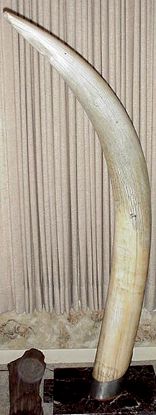
Elephant Ivory Tusk, at least
4.5 feet tall!
Ivory photo courtesy of a
Private Collector
|
|
Fossil, or mammoth ivory is the tusk of wooly mammoths preserved by freezing thousands of years ago. The tusks aren't true fossils, so although this material is commonly used, the name isn't accurate. Antique ivory is the preferred designation.
Bone looks and feels much different from ivory, although treated bone is sometimes sold as an ivory substitute. Chemically, ivory is similar to bone and antler, and comprises a collagen matrix with a mineral component. Unlike bone, ivory has no blood vessel system, and is therefore denser. Vegetable ivory, which comes from the tagua nut, is a widely used substitute. The seed of the ivory palm is another source of vegetable ivory.
Real ivory will show banding, rather like tree rings, when viewed in cross-section, as a new layer is added each year. Bone has stripes rather than banding, and vegetable ivory has no banding.
Ivory is soft, making it a timeless favorite for carving. Scrimshaw is ivory with incised designs.
|
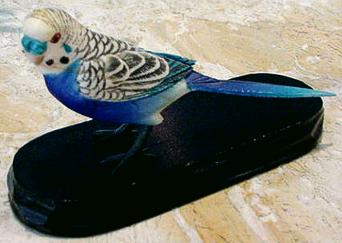
Painted Ivory carving
Ivory photo courtesy of a
Private Collector
|
When new, ivory is white or pale yellow. It darkens naturally with age, becoming darker yellow or brownish. It can be bleached with a careful application of peroxide, although most people value the patina age brings.
Because it is organic, ivory can be easily damaged if mishandled. It absorbs moisture if stored in damp conditions or cracks if allowed to dry out. It also contracts in the cold and expands in the heat. Ivory jewelry should never be immersed in water or subjected to harsh cleaners. Special care must be taken to keep moisture from the stringing material used with ivory beads, as it can ruin the beads from the inside out. Simply simply wiping it with a soft, damp cloth best cleans ivory.
Various substances have been used as imitation ivory, starting with celluloid. Plastic is currently the most common imitator. While it might look the same, it feels different. French ivory, Ivorette, and Ivorine are trademarked ivory imitations
Organic Gemstone
Chemical composition: calcium phosphate
Hardness: 2 - 3 |
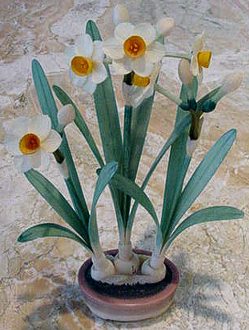
Painted Ivory carving
Ivory photo courtesy of a
Private Collector
|
|
From the article: Identifying Different Types of Ivory
Part of the Uniclectica Antiques and Collectibles Online Series "Caring For Your Antiques and Collectibles"
http://www.uniclectica.com/conserva/ivory1.html
The most commonly found ivories in North America come from elephant, walrus, sperm whale, and hornbill. It is possible to tell these ivories apart, as they are structurally different.
1. Elephant Ivory
This category includes ivory from both Indian and African elephants, as well as ivory from mammoths and mastodon. The tusks, or upper incisors, of these animals are used. They can have a cross section of up to 20cm (8"), and be up to 2.5m (almost 3 yards) long. They are oval in cross section, and are made up of a hard, dense tissue called dentin, which is made up of 70% inorganic material, and 30% collagen. Unlike human teeth, elephant tusks do not have an enamel coating. They do have a cementum layer, however; ivory dealers refer to this as the "bark" or the "rind". Occasionally this layer is retained on a piece of worked ivory. One-third to one-half of an elephant tusk is hollow.
Growth occurs as layer upon layer of calcified tissue is deposited on the interior of the tusk; you can see these concentric oval growth lines (called the Lines of Owen) in cross section. If you cut ivory lengthwise, these lines appear triangular. Fine and even near the hollow of the tusk (the pulp cavity), these lines become wavy and have milky areas between them as you get closer to the outside of the tusk.
Unique to elephant ivory are the Lines of Retzius. These fine intersecting lines are visible in cross section, and give an engine-turned effect (intersecting lines with a diamond shape between them).
Generally, elephant ivory has a fine, even grain and is easily carved in all directions. It can be thinly cut (i.e. for piano keys), and can be more delicately carved than bone. This ivory is often painted or stained, dyed, and gilded. When cut, the pores of the ivory fill with an oily substance, which helps the ivory polish up nicely. |
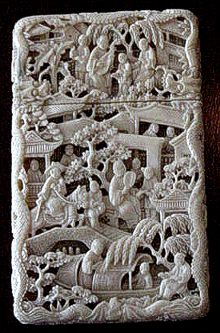
Carved Ivory box
Ivory photo courtesy of a
Private Collector
|
2. Hippopotamus Ivory
This is the second most commonly used ivory, after elephant ivory. Often used for flat items, such as buttons and inlays, it comes from the lower canines and incisors of hippos. The size varies, depending on the size of the animal.
The lower canine is curved, and has a triangular cross section; the incisor is straighter, and has a circular cross section. Both have two layers of dentin: an outer, primary dentin, and an inner, secondary dentin. The innermost layer has a marbled appearance that differs by species, and can even appear to have a greenish cast. The pulp cavities of these teeth are fairly small. Unlike elephant ivory, hippo ivory does have a thick enamel coating.
Hippo ivory is denser than elephant ivory, harder to carve, and has a finer grain. There is none of the "engine turned" effect in cross section; rather, hippo ivory has concentric rings in cross section. Finally, hippo ivory is less prone to decay than elephant ivory. |
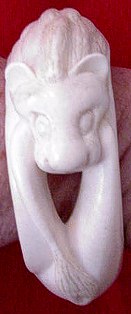
Carved Ivory bracelet
Ivory photo courtesy of a
Private Collector
|
3. Walrus Ivory
This ivory comes from the upper canines of walrus. It is oval in cross section, and can be over 2 feet in length. It has an inner dentin layer (which has a high mineral content; it forms as the tusk grows, and leaves a marbled look on finished objects), an outer dentin layer, and a smooth, dense cementum layer. Walrus ivory is used primarily for small objects.
4. Sperm Whale Ivory
Thirty teeth of the sperm whale can be used for ivory. Each of these teeth, up to 8" long and 3" across, are hollow for the first half of their length. Sperm whale ivory is easily confused with walrus ivory, as both have two distinct layers. The inner layer of sperm whale ivory, however, is much larger. As well, in a longitudinal section, sperm whale dentin has yellow "globules" included in the marbilization.
5. Hornbill Ivory
This comes from the casque or epithema of the Helmeted Hornbill, a bird native to the East Indies. It is distinguished from the rest of its family (the Bucerotidae) by having the front of its almost vertical and slightly convex epithema made of a solid mass of horn. This "horn" or "ivory" is quite hard and closely textured. This substance is used to make small objects such as buckles and brooches, and is highly valued by the Chinese. In cross section, you can see a bright yellow interior with a scarlet rim. |
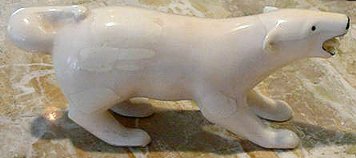
Ivory photo courtesy of a Private
Collector
|
6. Vegetable Ivory
The source of vegetable ivory is the inner seed of the South American ivory palm, and is thus completely made of cellulose (rather than collagen). These seeds are the size and shape of a small hen's egg, are very hard, and are solid all the way through. Vegetable ivory is smooth, takes a good polish, easily absorbs dyes, and is relatively inexpensive. It is used sed for small items only, such as dice and buttons. Since about WWII, plastics have largely replaced vegetable ivory.
7. Synthetic Ivories
Since 1865, when Alexander Parkes first invented it, celluloid has been used as an excellent ivory substitute. Casein has also been used. Names for these "faux ivories" include French Ivory, Ivoride, Genuine French Ivory, Ivorine, etc. Both grain patterns and the engine turned effect are added -- in general, the patterns of these are very regular in the fakes, and more irregular in the real thing. In instances of very good imitations (i.e. using celluloid), chemical tests are required to tell real ivory and the fakes apart. |
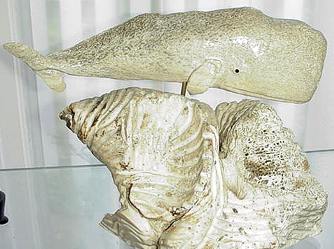
Carved Ivory Whale
Ivory photo courtesy of a
Private Collector
|
Under the Endangered Species Act, the African elephant is listed as a threatened species and the Asian elephant is listed as an endangered species. "Endangered" means a species is considered in danger of extinction throughout all or a significant portion of its range, and "threatened" means a species is considered in danger of becoming endangered. This protection prohibits elephant parts and products from being imported into the United States except under certain conditions.
In addition, elephants are protected under the Convention on International Trade in Endangered Species of Wild Fauna and Flora (CITES), an agreement among more than 120 nations to eliminate illegal trade in animals and plants, such as elephants, and their parts and associated products. The U.S. Fish and Wildlife Service is the federal agency responsible for the U.S. government's compliance with the CITES treaty.
The African Elephant Conservation Act of 1988 prohibits the import of raw or worked ivory into the U.S., with certain exceptions. It also set up a grant program to fund elephant conservation efforts.
In June 1989, the U.S. government imposed a ban on commercial importation of African elephant ivory into the country. This led to a commercial ivory trade ban being adopted by all CITES member nations later in 1989. |
|











